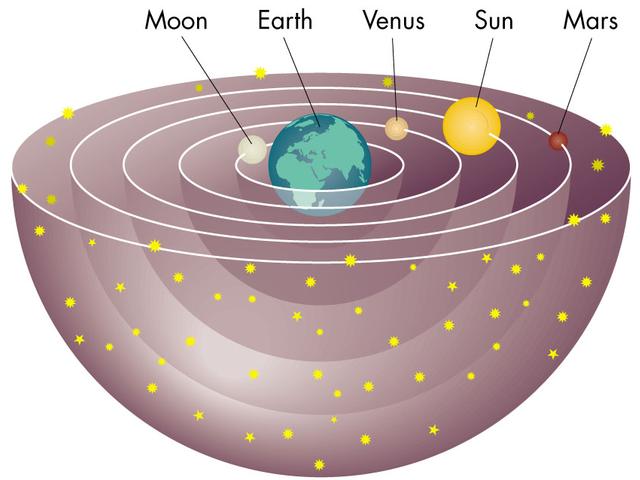There is a somewhat apocryphal anecdote about the philosopher, Ludwig Wittgenstein, that tells of him walking around Cambridge and asking passersby the question: “Tell me, why for so long did people think that the sun revolved around the earth?” Invariably, people would respond by saying something to the effect: “Because it looks that way, Herr Wittgenstein”. And Wittgenstein would then respond: “Please tell me then, how would it look if the earth revolved around the sun?”
The point of this anecdote, of course, is to illustrate how preconceived notions of the universe influenced the interpretation of the observed phenomena. Because humans saw themselves (and hence, the earth) as the centre of the universe (i.e., the geocentric conception of the universe), it was natural to interpret the rising and setting of the sun in terms of the sun’s movement around the earth, rather than vice versa. There were lots of “observed inconsistencies” (i.e., phenomena that did not fit the theory) associated with the geocentric conception of the universe. But it was easy to tweak the system, alter the orbits a bit and ultimately explain them away. When they couldn’t be explained, they were swept under the carpet and ignored. It hardly seemed appropriate to throw out the entire theory, because of a few inconsistencies. The basic assumption, namely that the earth was the centre of the universe, seemed to be common-sense and unassailable. It was only when people were prepared to change to a heliocentric conception of the universe that we began to explain many of these inconsistencies.
I related this anecdote about Wittgenstein and geocentrism for a specific reason. It took me many years to come up with an accurate analogy for the shortcomings of EBM. But I am of the opinion, and have been for some time, that EBM is in many ways analogous to Geocentrism: insofar as it is 1) the dominant paradigm of our time, 2) associated with innumerable anomalies and peculiar findings, and 3) it is based on a fundamental misconception about evidence and the world around us.
Like all analogies, this one between EBM and Geocentrism can be misleading and does not have perfect congruence. But I think it is close enough and ignominy way sheds light on the shortcomings of EBM and why EBM just doesn’t work. So please indulge me as we move forward.
As mentioned above, EBM has become the dominant paradigm as far as how to teach, learn and practice medicine. In fact, in the official declaration of EBM from the 1992 paper published by the Evidence-based medicine working group (EBMWG), the authors explicitly and unabashedly designate their approach as a “New paradigm for medical practice”. And they suggest that their idea, Evidence-Based Medicine, represents a “paradigm shift”. Whether EBM is a true paradigm in the Kuhnian sense or not is irrelevant. I think few people would contest the predominance of EBM within the medical world. Medical schools, residency training programs, conferences, journals all pay homage to it. The proliferation of books with the phrase “Evidence-Based Medicine” in their titles is further reinforcement of this. It is not an exaggeration to suggest that the dominance of EBM within medicine is almost biblical.
One of the interesting repercussions of EBM is that, while it initially was conceived as a way for physicians to critically evaluate literature and incorporate it into their practice, it’s impact has been much deeper. Because EBM determines the criteria for what constitutes good evidence in clinical research, it has directly impacted the way that research is done. Research is created in the image of Evidence-Based Medicine. It is analogous to students in a class being told that their assignments will be graded based on their use of large, complicated words. You can be pretty sure that there will be a copious proliferation of polysyllabic compositions. So it is with EBM. By determining standards for what is good research, it has determined how clinical research is done. It is the tail of EBM wagging the dog of clinical research. Or if you prefer religious analogies, it is like a deity which has created research in its own image.
As I mentioned above, I think there is a compelling analogy between EBM and Geocentrism and I suggested that EBM is at the present dominant paradigm of how to teach, learn and practice medicine. I also suggested that it has gives rise to numerous anomalous and peculiar outcomes and is based on a fundamental misconception about evidence and the world around us.
Now, I know that many people will think that this is a spurious analogy and I must be crazy. But I would ask you to seriously consider the following questions: Is it possible that the entire construct of Evidence-Based Medicine is premised on a misconception about the nature of evidence? Is it possible that at the heart of the EBM paradigm lies a misguided and fallacious assumption, which corresponds in many ways to Geocentrism’s notion of the earth as the centre of the universe? Is it possible that the apparent common-sensical approach to patient care, which EBM promotes, belies a misleading understanding about clinical evidence and medical knowledge? Is it possible that the apparent improvements in medicine and medical care over the past several decades have not really occurred because of EBM?
These are very provocative questions, especially when one considers the privileged and dominant position which EBM occupies in the sphere of medical education and practice.
But as I suggested above, it is my firm contention that EBM is analogous to the geocentric conception of the universe, insofar as at the heart of this dominant and common-sensical paradigm lies a basic misconception about the nature of clinical phenomena and how we measure it. But this is a theoretical argument, which, regardless how well my argument is executed, will not likely persuade many practicing physicians or proponents of EBM. Moreover, it is important to note that the Geocentric Conception of the Universe, even though it was based on a major misconception, did explain a great deal of phenomena and did appear to have more than modest success at predicting the movements of celestial bodies. There were just numerous “observed inconsistencies”, for which it could not account.
It is for these reasons that I will take my start here, not from a theoretical critique of Evidence-Based Medicine, but rather from a discussion of “observed inconsistencies”. If the contention above is correct, and EBM is, indeed, analogous to the geocentric conception of the universe, then there should be plenty of examples of “inconsistencies”: i.e., phenomena which really don’t make much sense, but which are tolerated and accommodated because of the general acceptance of the EBM paradigm. In fact, many “inconsistencies” may not at first glance be appreciated as inconsistencies, because most of us have become so accustomed to encountering them. Anomalies and peculiar results have become just a natural part of practicing Evidence-Based Medicine, of the Evidence-Based Medicine Paradigm.

